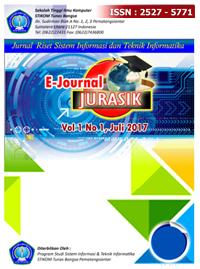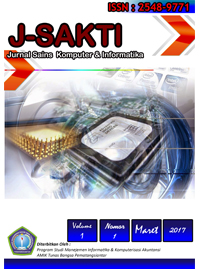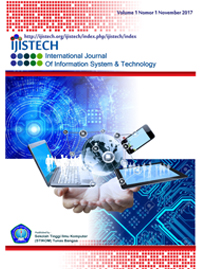Penerapan Metode Multi Attribute Utility Theory Pada Peserta Didik Penerimaan Bantuan Operasional Penyelenggara (BOP) Pendidikan Anak Usia Dini
Abstract
Full Text:
PDFReferences
S. R. Rani, R. Rizka, and A. Perdana, “Analisis Metode Profile Matching Pada Rekomendasi Cat Dinding Rumah Berdasarkan Konsumen,” vol. 17, 2018.
P. Sianturi, P. Ramadhani, and N. W. Al-hafiz, “SISTEM PENDUKUNG KEPUTUSAN PENENTUAN PENERIMA BANTUAN OPERASIONAL PENYELENGARAAN ( BOP ) PAUD ( PENDIDIKAN ANAK USIA DINI ) MENERAPKAN METODE ELECTRE ( STUDI KASUS : DINAS PENDIDIKAN KABUPATEN SIMALUNGUN ),” vol. I, pp. 20–26, 2017.
R. A. Hutasoit, S. Solikhun, and A. Wanto, “Analisa Pemilihan Barista dengan Menggunakan Metode TOPSIS (Studi Kasus: Mo Coffee),” KOMIK (Konferensi Nasional Teknologi Informasi dan Komputer), vol. 2, no. 1, pp. 256–262, 2018.
T. Imandasari, A. Wanto, and A. P. Windarto, “Analisis Pengambilan Keputusan Dalam Menentukan Mahasiswa PKL Menggunakan Metode PROMETHEE,” Jurnal Riset Komputer (JURIKOM), vol. 5, no. 3, pp. 234–239, 2018.
M. Masitha, D. Hartama, and A. Wanto, “Analisa Metode (AHP) pada Pembelian Sepatu Sekolah Berdasarkan Konsumen,” Seminar Nasional Sains & Teknologi Informasi (SENSASI), vol. 1, no. 1, pp. 338–342, 2018.
S. R. Ningsih, D. Hartama, A. Wanto, I. Parlina, and Solikhun, “Penerapan Sistem Pendukung Keputusan Pada Pemilihan Objek Wisata di Simalungun,” in Seminar Nasional Teknologi Komputer & Sains (SAINTEKS), 2019, pp. 731–735.
L. P. Purba, A. P. Windarto, and A. Wanto, “Faktor Terbesar Rendahnya Minat Ber-KB (Keluarga Berencana) dengan Metode ELECTRE II,” Seminar Nasional Sains & Teknologi Informasi (SENSASI), vol. 1, no. 1, pp. 369–374, 2018.
N. Rofiqo, A. P. Windarto, and A. Wanto, “Penerapan Metode VIKOR Pada Faktor Penyebab Rendahnya Minat Mahasiswa Dalam Menulis Artikel Ilmiah,” Seminar Nasional Sains & Teknologi Informasi (SENSASI), vol. 1, no. 1, pp. 228–237, 2018.
S. Sundari, S. M. Sinaga, I. S. Damanik, and A. Wanto, “Sistem Pendukung Keputusan Pemilihan Peserta Olimpiade Matematika SMA Swasta Teladan Pematangsiantar Dengan Metode Electre,” in Seminar Nasional Teknologi Komputer & Sains (SAINTEKS), 2019, pp. 793–799.
S. Sundari, A. Wanto, Saifullah, and I. Gunawan, “Sistem Pendukung Keputusan Dengan Menggunakan Metode Electre Dalam Merekomendasikan Dosen Berprestasi Bidang Ilmu Komputer (Study Kasus di AMIK & STIKOM Tunas Bangsa),” in Seminar Nasional Multi Disiplin Ilmu, 2017, pp. 1–6.
A. Wanto and H. Damanik, “Analisis Penerapan Sistem Pendukung Keputusan Terhadap Seleksi Penerima Beasiswa BBM (Bantuan Belajar Mahasiswa) Pada Perguruan Tinggi Menggunakan Metode Simple Additive Weighting (SAW) (Studi Kasus : AMIK Tunas Bangsa Pematangsiantar),” in Seminar Nasional Rekayasa (SNTR) II, 2015, no. 2, pp. 323–333.
A. Wanto and E. Kurniawan, “Seleksi Penerimaan Asisten Laboratorium Menggunakan Algoritma AHP Pada AMIK-STIKOM Tunas Bangsa Pematangsiantar,” Jurnal Informatika dan Komputer (JIKO), vol. 3, no. 1, pp. 11–18, 2018.
M. Widyasuti, A. Wanto, D. Hartama, and E. Purwanto, “Rekomendasi Penjualan Aksesoris Handphone Menggunakan Metode Analitycal Hierarchy Process (AHP),” Konferensi Nasional Teknologi Informasi dan Komputer (KOMIK), vol. I, no. 1, pp. 27–32, 2017.
N. Hadinata, “Implementasi Metode Multi Attribute Utility Theory ( MAUT ) Pada Sistem Pendukung Keputusan dalam Menentukan Penerima Kredit,” vol. 7, no. September, pp. 87–92, 2018.
DOI: http://dx.doi.org/10.30645/senaris.v1i0.63
Refbacks
- There are currently no refbacks.
 








